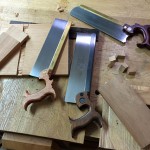RWW 187 Which Saw to Get First
 I get asked which saw a beginning woodworker or even someone wanting to use more hand tools should buy first. There are a lot of things that make this answer “it depends” but I feel pretty strongly that it should be a carcass saw. This video is a detailed look at why it should be the first saw you buy and depending on how much hand tool work you do, maybe the last saw you buy.
I get asked which saw a beginning woodworker or even someone wanting to use more hand tools should buy first. There are a lot of things that make this answer “it depends” but I feel pretty strongly that it should be a carcass saw. This video is a detailed look at why it should be the first saw you buy and depending on how much hand tool work you do, maybe the last saw you buy.
PS: sorry I forgot to correct for the fisheye effect in a few of the wide angle shots, I think it looks kinda cool, but I’m sure someone out there won’t like it.
Saws Used in the Episode
- Bad Axe Small Tenon Saw with Hybrid Filing
- Lie Nielsen Carcass Saw
- Bontz Toolworks Carcass Saw
- Bad Axe Sash Saw
- Bad Axe Dovetail Saw
- Bad Axe Stiletto Saw
- not show but still a great saw is the Veritas Carcass Saw
- don’t forget the vintage Market and guys like Hyperkitten or Jim Bode Tools


